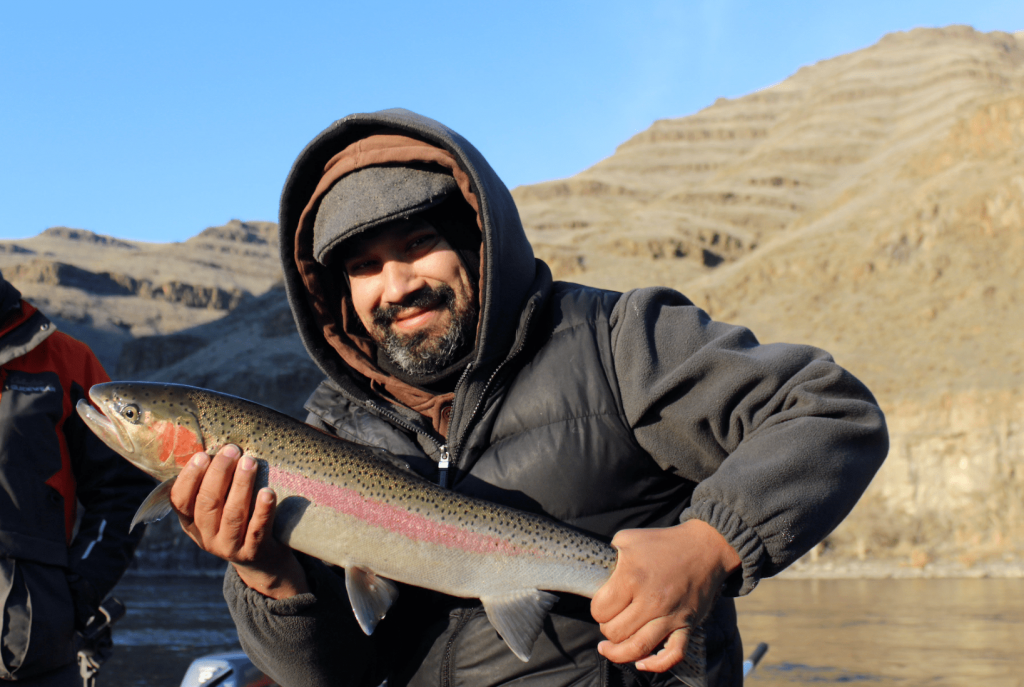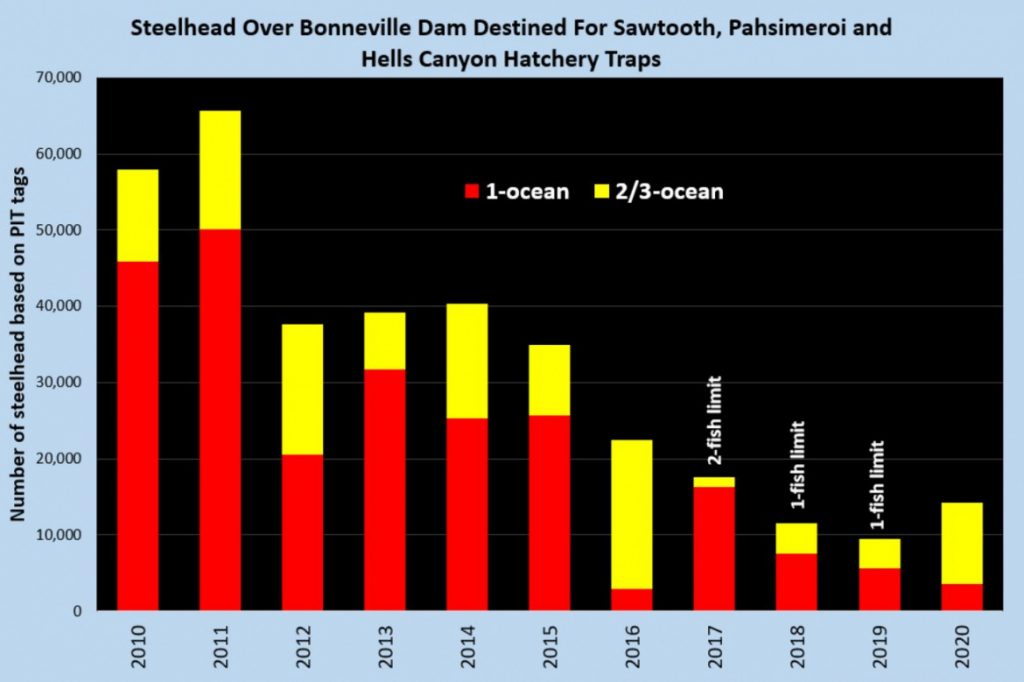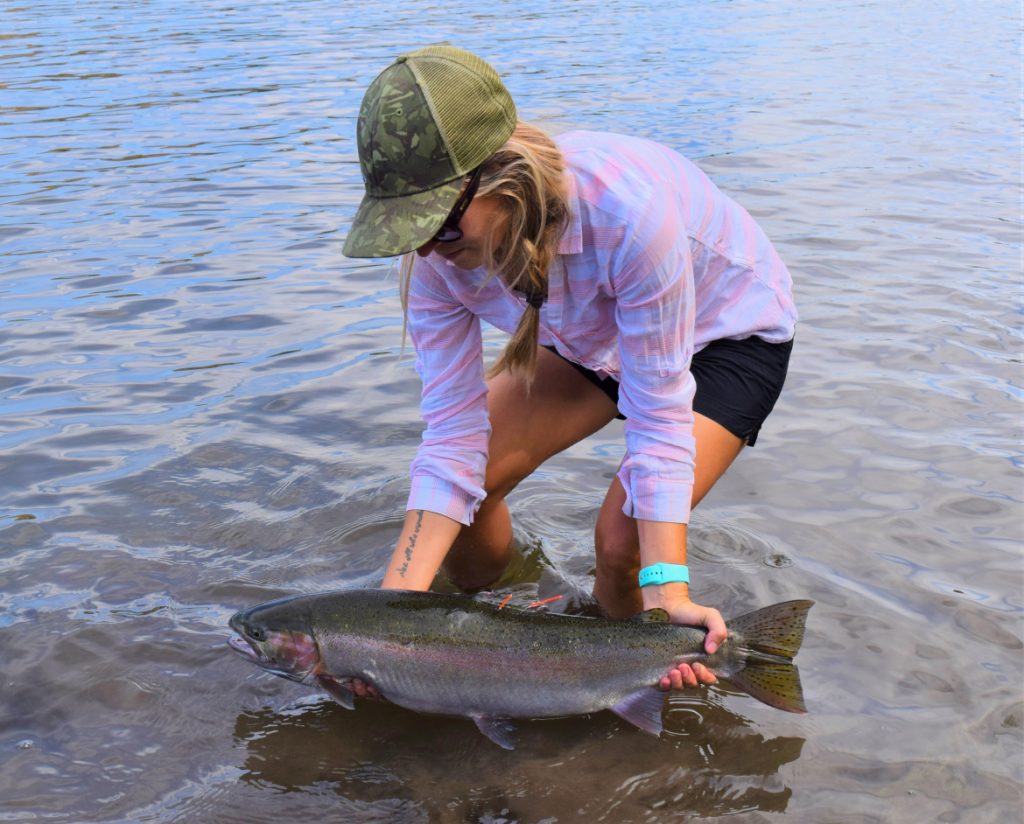
Snake, Tribs Mostly Opening For Steelhead; Bag Limit Up A Fish From 2019 In Many Rivers
Even as they’ve been able to ease some of last year’s tight restrictions on steelheading in the Snake system thanks to a larger run this season, managers are also watching something unusual going on with 2020’s fish.
“We usually see 80 percent one-salt and 20 percent two-salt, but it’s the opposite of that right now – 80 percent two-salt, 20 percent one salt,” said Jeremy Trump, a Washington Department Fish and Wildlife biologist based in Dayton, this evening.
Why are most steelhead suddenly staying out in the ocean an extra year, essentially turning A-runs into B-runs?

Damn good question.
When asked, Trump echoed some of the theories that Idaho Department of Fish and Game’s Clearwater Region manager Joe DuPont posted in a mid-August blog.
“It could be that many of these fish didn’t reach large enough size their first year in the ocean to trigger a signal for them to return, and they remained another year in the ocean. It could be that survival for those fish spending their second year in the ocean was unusually good,” DuPont wrote.

Steelhead are a remarkably plastic fish and perhaps they are taking advantage of improving conditions in the Pacific after a period of poor productivity and small runs to rebuild themselves.
“You could speculate all day long on what’s going on in the ocean and not really know until the fish come back,” Trump said.
With the Sept. 1 start of the fishery, IDFG, WDFW and ODFW have put out rule changes in recent days generally announcing that daily limits will be up a fish from where they were in 2019, though still one a day on several western Blue Mountains rivers in Washington.
Last year saw the worst Snake steelhead run in 40 years — just 35,084 at Lower Granite Dam – which led to reduced limits and closures on the Snake itself to try and get as many steelhead back to the hatcheries and gravel.
“We need to make it clear to steelhead anglers that this is not a strong run by any measure. However, it is an improvement over the last couple years and will provide some harvest opportunity,” said Lance Hebdon, IDFG anadromous fisheries manager, in a press release out last week.


Fishing is typically best in October and November, and again in March and April as the spring spawn nears.
Kyle Bratcher, ODFW’s fish biologist in Enterprise, says eggtake needs are expected to be met on the south side of the Blues but caution is still warranted.
“While we expect to meet broodstock collection goal, we’re dealing with small margins for error. Managing conservatively ensures we can overcome any unforeseen circumstances if they arise,” Bratcher said in another news release.
Managers forecast 95,500 Inland Northwest hatchery and wild summer steelhead will enter the Columbia this year and over the coming months mostly return to Snake tribs such as Washington’s Walla Walla, Touchet, Tucannon, and Grande Ronde, Idaho’s Salmon and Little Salmon, and Oregon’s Grande Ronde and Imnaha, but also to rivers in North-central Washington and North-central Oregon.
Last week a technical committee reviewing dam count data said that 2020’s run is “tracking consistent with the preseason forecast.”
In an effort to protect wild steelhead, ODFW and WDFW managers have barred fishing or retention in several Columbia Gorge thermal refuges, which the fish dip into to get out of the warmer mainstem during their upstream migration.
Earlier this summer WDFW preemptively closed the Washington Snake on expectations of a low run, but with more information on the run, today the agency announced that the limit on the river from the mouth up to Lower Granite Dam would be one a day and from the dam to the Idaho-Oregon state line would be two.
That coincides with the hatchery fall Chinook fishery set to open Sept. 1 from the mouth to Lower Granite and basically Clarkston to the state line.
Meanwhile, Idaho has yet to make a decision on the popular Clearwater steelhead fishery.


“You will have to wait because these fish are just starting to pass over Bonneville Dam, and it won’t be until mid-September until we have a good feel for what this return will be like,” said DuPont in that blog post.
Just as with Southeast Washington rivers, tag data shows that 75 percent of the steelhead expected to return to Idaho’s Salmon system appear to have spent two to three years at sea, the opposite of most years when they’re out for one.
It also happened with 2016’s run, which would have been at sea during the peak of The Blob years. There have been recurring marine heatwaves in the North Pacific since then.

IDFG and the University of Idaho also recently detailed the beginning of year two of a steelhead tagging study to figure out how often hatchery and wild fish are caught.
They aim to tag 1,000 fin-clipped fish and 1,000 unclipped fish at Lower Granite.

Last year’s effort saw 878 tagged and 200 of those subsequently reported as caught.
“In the first year of the study, the encounter rate for Idaho’s wild fish was about 35% while the hatchery fish encounter rate was about 40% to 45%. With wild steelhead conservation being a primary concern for IDFG, this is good news because it means the wild steelhead encounter rate estimated in the past may have been conservative,” a UI writeup stated.

